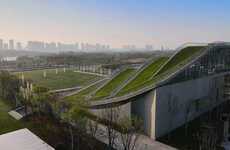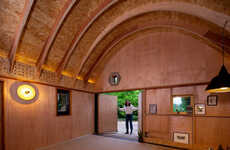
The Doozy Access Art Gallery in Shanghai Boasts a Fragmented Facade
Elena Rahman — January 26, 2022 — Art & Design
References: farworkshop & designboom
The Doozy Access Art Gallery is located in Shanghai, China. Far Workshop, an interdisciplinary design practice, transformed an industrial warehouse into an art gallery while maintaining some of the building's original aesthetics. The building's exterior features a fragmented facade with black angular volumes integrated into the White walls, creating a visual juxtaposition.
The designers aimed to create a black curtain effect on the building's facade. Doozy Access Art Gallery aims to reflect its internal artistic rhythm on the building's exterior. It accomplishes this by repeating window frames in each bay and incorporating a non-traditional spatial language into the design. The fragmented facade is meant to disturb the typical rhythm of architectural design with its geometric shapes.
Image Credit: Songkai Liu, designboom, farworkshop
The designers aimed to create a black curtain effect on the building's facade. Doozy Access Art Gallery aims to reflect its internal artistic rhythm on the building's exterior. It accomplishes this by repeating window frames in each bay and incorporating a non-traditional spatial language into the design. The fragmented facade is meant to disturb the typical rhythm of architectural design with its geometric shapes.
Image Credit: Songkai Liu, designboom, farworkshop
Trend Themes
1. Industrial Art Galleries - The rise of industrial art galleries that transform abandoned warehouses/industrial buildings into unique gallery spaces.
2. Non-traditional Spatial Language - The use of non-traditional spatial language that disrupts the typical rhythm of architectural design.
3. Fragmented Facade - The use of fragmented facades that create a visual juxtaposition and disturb the typical rhythm of architectural design.
Industry Implications
1. Art and Culture - The art and culture industry can partner with property developers to turn abandoned warehouses and industrial buildings into unique gallery spaces.
2. Architecture and Design - The architecture and design industry can explore the use of non-traditional spatial language to disrupt the typical rhythm of architectural design.
3. Construction - The construction industry can innovate the use of fragmented facades that not only provide aesthetic value but also functional value to a building's facade.
1.9
Score
Popularity
Activity
Freshness























